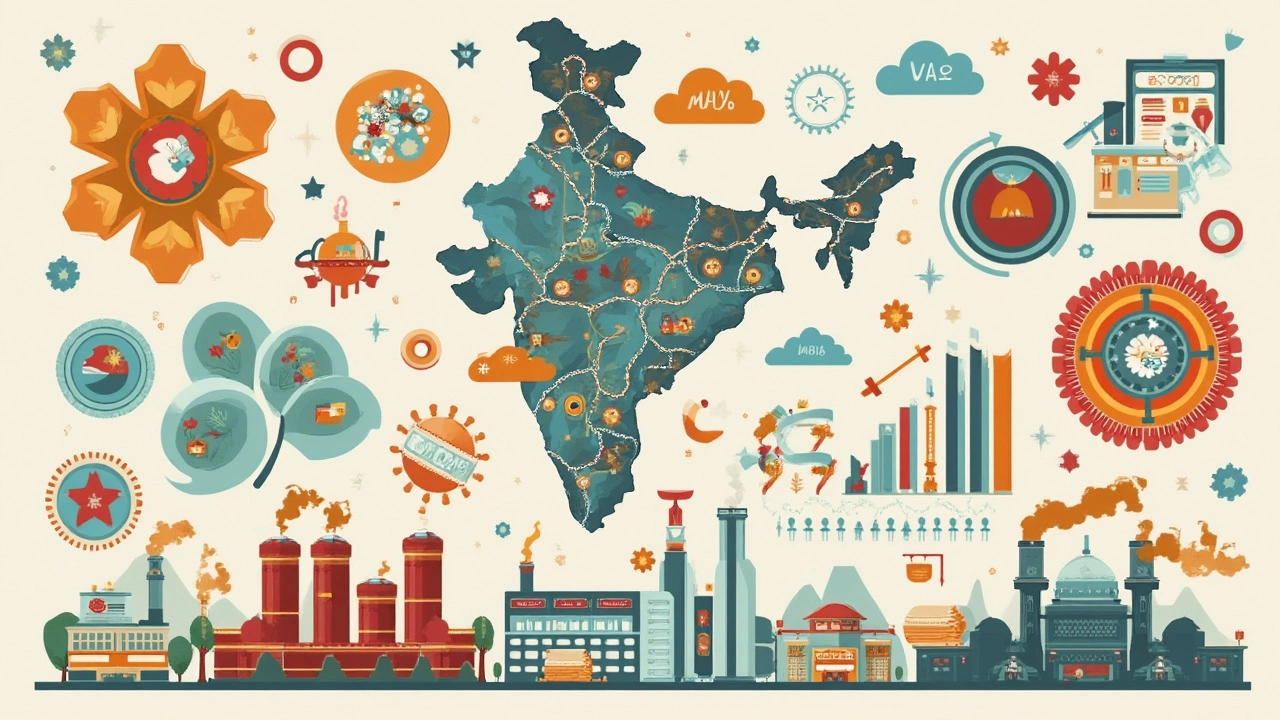Did you know that India is called the 'pharmacy of the world' for good reason? There's a whole universe of pharma manufacturers churning out everything from everyday painkillers to life-saving cancer drugs. Most people imagine a few big factories, but the sheer scale of pharma manufacturing companies in India surprises even those who track global industries. This isn't just big business—it's essential for millions around the world. If you're browsing your medicine cabinet tonight, chances are pretty high you'll spot something either made in India or using ingredients sourced from there. Let's take a deep look at how many pharma companies operate in India and why this ecosystem matters so much, not just at home but across the globe.
How Many Pharma Manufacturing Companies Exist in India?
India isn’t just a country where medicines get invented—it’s where they get made, in bulk, at record pace. As of June 2025, India is home to over 3,000 active pharmaceutical manufacturing companies. But that's just the tip of the iceberg. If you count smaller players, contract manufacturers, and units making intermediates or bulk drugs, the number shoots past 10,500, according to the Indian Drug Manufacturers' Association (IDMA).
This isn’t some vague estimate. The Ministry of Chemicals and Fertilizers, which oversees pharma regulations in India, published data last year in 2024 confirming these numbers. There are big names everyone has heard of, like Sun Pharma, Dr. Reddy’s Laboratories, Cipla, Lupin, and Aurobindo Pharma. But there’s a thriving backbone of small-to-mid-size manufacturers who work quietly but decisively to fill shelves from Europe to Africa to the Americas.
Some might assume that only the big cities are the main hubs. The real picture shows strong clusters in states like Maharashtra, Gujarat, Andhra Pradesh, Telangana, and Himachal Pradesh. The presence of dense pharma parks and special economic zones in these areas is no accident. Cities like Hyderabad and Ahmedabad compete fiercely, with each home to more than 300 licensed manufacturers alone.
Here's a quick look at the concentration:
| State | No. of Pharma Companies (2025) |
|---|---|
| Maharashtra | 1,200+ |
| Gujarat | 1,100+ |
| Andhra Pradesh & Telangana | 1,100+ |
| Himachal Pradesh | 800+ |
| Tamil Nadu | 600+ |
| Goa | 380+ |
The industry is regulated by the Central Drugs Standard Control Organization (CDSCO), which ensures every player meets strict local and international standards. You’ll find that many Indian companies are approved by the US FDA and the European Medicines Agency.
One fascinating bit? India is the only country with the most US FDA-approved pharma manufacturing plants outside the US itself. That's over 600 Indian plants meeting some of the world’s strictest safety and quality rules.
India's Pharma Sector: More Than Just Numbers
Counting companies paints only part of the picture. What really sets India apart is its ability to scale up production rapidly and adapt to changing global needs. During the pandemic, Indian pharma companies delivered billions of doses of paracetamol, remdesivir, and hydroxychloroquine across the globe.
What fuels this massive engine? India produces more than 60% of vaccines supplied to developing countries. It’s also the largest supplier of generic medicines worldwide—making one out of every five generic pills taken anywhere on the planet. The pharma manufacturing companies India keyword is your window into a booming ecosystem that never sleeps.
“India has, over the last 15 years, built both depth and reliability in pharmaceutical manufacturing, leading to visible global trust,” said Sudarshan Jain, Secretary-General of the Indian Pharmaceutical Alliance, in a 2024 panel discussion.
From a business perspective, the sector pulls in around $70 billion in annual revenue and is expected to reach $130 billion by 2030, thanks to both exports and growing domestic demand. This isn’t just about companies. It’s millions of jobs, from scientists to warehouse staff, directly involved in getting safe medicine out the door.
The role Indian pharma plays in global healthcare isn’t just about volume. India’s strength lies in affordable pricing. For example, the country supplies 40% of all generic drugs sold in the US and 25% of all medicine dispensed in the UK, according to a 2023 UK government report.
It's easy to assume this would mean cutting corners, but Indian companies keep pace with Good Manufacturing Practices (GMP) laid out by the World Health Organisation. Annual inspections, surprise audits, and transparent reporting become the norm, not the exception.

Key Factors Behind the Growth of Indian Pharma Manufacturing
So, why does India lead in pharmaceutical manufacturing? Cheap labor is just one factor, but it tells only a tiny part of the story. Decades of government backing, smart legislation, and a massive pool of English-speaking graduates are the real drivers. Pharmacy degrees flood the market every year, and many of these young professionals go straight into R&D or quality control labs.
India’s well-developed supply of raw materials, especially Active Pharmaceutical Ingredients (APIs), keeps costs under control and timelines short. Although there was a hiccup in 2020 when global supply chains went haywire, Indian companies responded by fast-tracking projects to build API factories at home, taking back control from foreign suppliers.
The government rolled out ‘Production Linked Incentive’ (PLI) schemes in 2021, which gave financial boosts to companies that invest in new technologies, automation, or green chemistry—a tactic that paid off. So, the latest production lines in cities like Hyderabad look more like spaceship assembly plants than old-school medicine factories.
One interesting angle: the homegrown focus on generic medicine. While big Western pharma giants pour billions into new drug molecules, Indian companies specialize in taking these innovations and producing them cheaply once patents expire. This trickle-down innovation means newer, cheaper drugs reach patients faster and at much lower prices.
The success is contagious. Pharma universities like NIPER (National Institute of Pharmaceutical Education and Research) pump out a steady flow of experts. And thanks to low regulatory hurdles and affordable infrastructure, even a mid-sized entrepreneur with a decent idea can launch a small manufacturing unit in a few months.
Challenges Indian Pharma Manufacturers Face
It isn’t all easy. Indian pharma manufacturing companies work in a tough environment. For every headline about a blockbuster export deal, there’s a story of rising raw material costs, regulatory headaches, or sudden export bans. Quality lapses can bring down the hammer; dozens of companies have, in recent years, faced warnings or bans from US and European regulators when products didn’t meet the mark.
Counterfeit medicines remain an ongoing headache. The government has worked to clean up supply chains with barcoding and digital tracking, but it’s a game of cat and mouse. Greener manufacturing processes are another hurdle—regulations push for less waste and eco-friendly solvents, but these upgrades cost money.
There’s also no escaping global politics. Changes in trade rules, a pandemic, or tensions with big chemical suppliers like China can play havoc with India’s plans. Exporting companies must clear more hurdles than ever: shipping delays, new paperwork, and ever-tightening scrutiny from importing countries.
Yet, Indian firms have proved nimble. They’ve cracked down on substandard operations, invested in quality labs, and now even use AI for quality control and predictive maintenance. In Pune and Bangalore, some companies recently started using blockchain for supply chain transparency, keeping fakes off shelves and reassuring regulators abroad.
Rising wages and urban pressures force companies to locate new factories in smaller towns, offering jobs and fresh opportunities in places you might never have heard of, like Baddi and Sikkim. It’s not just a struggle; it’s also a story of hustle, adaptability, and ambition.

How Indian Pharma Companies Are Shaping the Future
Indian pharma isn’t interested in standing still. You'll see a focus now on biologics (think: new-age cancer therapies and vaccines), biosimilars, and advanced drug delivery. Rather than just copying, more companies are beginning to invent. Glenmark Pharmaceuticals made headlines in 2023 with its first-in-class asthma drug. Zydus Cadila was out early with a Covid-19 DNA vaccine, something no one expected from a non-Western company.
Companies also chase greener processes, making tablets and syrups without the heavy chemical footprint. The future belongs to companies that mix speed, cost, and environmental responsibility, and India’s younger pharma manufacturers want to lead that charge. There's a race to adopt AI in R&D—for example, using computer models to predict the best combination of molecules, saving years of work and millions in expenses.
These new approaches go hand in hand with new regulations. The Indian government has introduced rules to speed up approvals for new medicines. Pharma zones in Telangana and Gujarat test everything from next-generation antibiotics to mRNA vaccines. You might not see this on the nightly news, but behind closed factory gates, the Indian pharma sector is quietly reinventing itself.
Don’t be surprised if, five years from now, more of your advanced, personalized medicine comes from India—or from a home-grown company that started as a small Hyderabad workshop but is now a global name. Whether it’s cutting prices on common painkillers or rolling out breakthroughs, the story of Indian pharma manufacturing keeps rewriting what’s possible in health and business, proving that numbers only scratch the surface.
